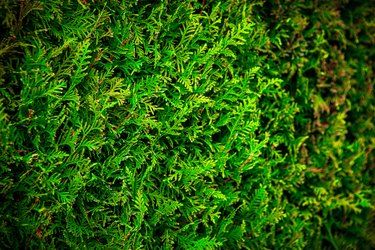
Cedar hedges are made by planting cedar trees close together to achieve natural fencing. They can be pruned for desired height and provide long-term privacy shielding. If it becomes necessary to move the hedge to a different location, it can be done without losing the plants, but some precautions and proper handling of the trees are necessary. However, not all cedar hedges are true cedars.
Health of Cedar Hedges
Video of the Day
Move the cedar hedge at the proper time of year to avoid stressing it unnecessarily. Cooler months, such as in the fall, are more appropriate. Do not move the cedar hedge if it is already looking stressed from heat or drought or appears to be dying.
Video of the Day
The hedge should be pruned in July to give it a bottom-heavy look, removing dead branches and unwanted foliage that makes it unnecessarily top heavy prior to moving. Pruning will also make it easier to move each individual shrub. If necessary, prune lightly between the plants to remove any intertwining branches.
Proper Retrieval of Cedar Hedges
Cedar hedge root balls are usually planted very close together, so roots may be intertwined underground. When removing the hedge, begin with one end. Start digging several feet out from the hedge to determine where the root line begins. Move inward until the roots are discovered, and then dig around each plant at an angle, digging below the roots.
Most cedar roots tend to be shallow, so extensive deep digging should not be required. Once the entire circumference of the tree root ball is dug out, carefully lay the tree over on its side and pull it gently from the soil. This will be continued down the line of the hedge. If the plants are being moved close by, it is recommended to transplant each one as it is removed, but that may not be possible if they are being transported elsewhere.
Preparation of New Site
Look over the new transplant site to make sure that the cedars will receive full sun to partial shade; do not transplant them to a full-shade area. Do not place the new hedge next to a road or sidewalk where salt will be used in the winter, as this can kill cedar; instead, when transplanting cedar trees to an area where road salt is used, place the transplanted tree at least 3 feet away.
Dig a hole as deep as the root ball of the cedar that will be transplanted and at least twice as wide. The hole may need enlarging if the root ball is larger than initially thought. Water the soil in the hole thoroughly just before placing the root ball into it.
Correct Planting Methods
Hold the transplanted tree firmly in place while shoveling the excavated soil around the root ball; if necessary, have a second person hold the tree steady. Use your feet to apply pressure until the tree is stabilized in the soil, adding soil as needed.
Water the transplanted tree with a soaking hose for several hours, if possible; it is recommended to do this each morning and evening for the first two weeks after transplant. Place cedar mulch around the base of the hedge to retain moisture, and wait six months — or until the following spring — to add any fertilizer.
Types of Cedar Hedges
Cedar hedges may be Japanese cedar (Cryptomeria japonica), which grow in USDA zones 5-8. Another common hedge that resembles cedar but isn't is arborvitae (Thuja occidentalis), also known as white cedar, which grows in zones 3-7. The Eastern red cedar (Juniperus virginiana), which grows in zones 2-9, is another tree commonly grown as a hedge that is not a true cedar.